| Srl | Item |
| 1 |
ID:
019224


|
|
|
|
|
| Publication |
Jan-March 2001.
|
| Description |
124-136
|
|
|
|
|
|
|
|
|
|
|
|
|
|
|
|
| 2 |
ID:
076386


|
|
|
| 3 |
ID:
109077


|
|
|
|
|
| Publication |
2011.
|
| Summary/Abstract |
The U.S. Navy SEAL raid in Abbottabad, Pakistan, and Islamabad's subsequent turn toward China have highlighted one of the most remarkable legacies of the Cold War: the persistence of a strategic triangle composed of China, Pakistan, and the United States. Throughout much of the Cold War, China and the United States competed to keep Pakistan within their particular sphere of influence, while Pakistan deftly took advantage of the subtle power struggle to improve its security profile vis-à-vis India. Despite persistent competition, the nations of the strategic triangle enjoyed three major convergence points: (1) the 1969-71 period, when Pakistan acted as a conduit for secret talks between Beijing and Washington, which subsequently led to mutual coordination during the 1971 Indo-Pakistan war; (2) the decade following the Soviet Union's invasion of Afghanistan in 1979; and (3) the years following the 9/11 attacks in the United States, when global focus turned to Afghanistan and terrorism. This third convergence around terrorism is particularly salient, as Pakistan is increasingly viewed globally as both a source of terrorist activity and a victim of terrorist violence. In the long term, the strategic triangle may act as a modulating force that may prevent instability within nuclear-capable Pakistan, as well as constrain activities by certain Pakistani state organs that may be linked to the proliferation of weapons of mass destruction and clandestine support for militant organizations.
|
|
|
|
|
|
|
|
|
|
|
|
|
|
|
|
| 4 |
ID:
065760


|
|
|
| 5 |
ID:
142718
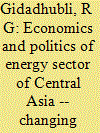

|
|
|
|
|
| Summary/Abstract |
Central Asia is one of the energy resource rich regions in the world. For the post-Soviet sovereign and independent Central Asian States (CAS), energy sector has assumed special political and economic significance during the last two decades. The leadership of the CAS has to deal with the geo-political influence of the global powers apart from the fact that their energy sector, being integrated with the global energy market, has also to deal with the cost and benefit of fluctuating international demand and price for oil.
|
|
|
|
|
|
|
|
|
|
|
|
|
|
|
|
| 6 |
ID:
165146


|
|
|
|
|
| Summary/Abstract |
Small states throughout the Asia-Pacific are confronted by a growing dilemma over how to balance their traditional security ties with the US and rapidly growing trade with China. This gives Washington and Beijing potential leverage over small states to use within their competition with one another. This article explores the implications of this for New Zealand – a small South Pacific state that prides itself on maintaining an independent foreign policy. Situated within the small state literature, it utilises a material-based strategic triangle to illustrate the fundamental facets of New Zealand's position. Relatedly, the article examines how Wellington has managed its burgeoning relations with China and the US over the past decade and critically considers New Zealand's independent foreign policy. It finds that New Zealand has adopted a mixed set of strategies to manage its position between the US and China, closely aligning itself with Washington while remaining nonaligned on some key security issues in the Asia-Pacific region. New Zealand has certainly not opted for neutrality. The article concludes that New Zealand and other small states must remain vigilant, may want to consider alternative strategies of alignment, and outlines a number of areas where additional research could prove fruitful.
|
|
|
|
|
|
|
|
|
|
|
|
|
|
|
|
| 7 |
ID:
068865
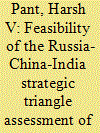

|
|
|
| 8 |
ID:
061839
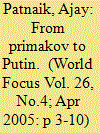

|
|
|
| 9 |
ID:
066883
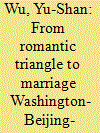

|
|
|
| 10 |
ID:
052115


|
|
|
|
|
| Publication |
Apr-Jun 2004.
|
|
|
|
|
|
|
|
|
|
|
|
|
|
|
|
| 11 |
ID:
159952
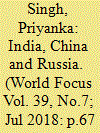

|
|
|
|
|
| Summary/Abstract |
The relations between Russia, China and India have widespread implications not only for bilateral relations among them, but also for the wider Indo- Pacific region. The China, Russia and India triangle heralds a situation where two sides, China and Russia, have grown much closer to each other, with India in danger of losing out in this process.
|
|
|
|
|
|
|
|
|
|
|
|
|
|
|
|
| 12 |
ID:
056423


|
|
|
| 13 |
ID:
189036
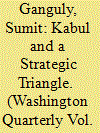

|
|
|
|
|
| Summary/Abstract |
In the wake of the American withdrawal from Afghanistan and the Taliban takeover, three major regional states—Pakistan, India, and the People’s Republic of China (PRC)—all have significant and overlapping stakes in the future of Afghanistan. As the Taliban struggles to govern an utterly impoverished land, all three have been carefully monitoring developments in the country. Simultaneously, they are keeping a close watch on the choices of the other two. As this essay argues, all three states are keen on ensuring that they will be able to wield a modicum of influence in the country for different as well as overlapping reasons. Pakistan’s goals will remain geostrategic: ensuring that the Taliban maintain their anti-India stance and sympathy for Islamabad’s concerns. The PRC’s interests in the country, meanwhile, will be twofold, both economic and strategic. It will look for ways to obtain access to rare earths and simultaneously attempt to ensure that pan-Islamic sentiment does not percolate from Afghanistan into its restive province of Xinjiang. Chinese and Pakistani interests in Afghanistan are likely to dovetail. Consequently, in all likelihood the US will turn to India to deal with concerns about the PRC, and also for intelligence cooperation purposes.
|
|
|
|
|
|
|
|
|
|
|
|
|
|
|
|
| 14 |
ID:
082911


|
|
|
| 15 |
ID:
017734


|
|
|
|
|
| Publication |
Fall 2000.
|
| Description |
541-555
|
|
|
|
|
|
|
|
|
|
|
|
|
|
|
|
| 16 |
ID:
062255


|
|
|
| 17 |
ID:
122585


|
|
|
| 18 |
ID:
142717


|
|
|
|
|
| Summary/Abstract |
Energy resources are reshaping the geopolitical map in Eurasia. Eventual control of the development of oil deposits as well as the eventual pipeline routing will determine the political and economic future of Russia, Turkey and the Central Asian states; it will determine Iran’s position in the region and its relations with the West; it will determine the realignment of the strategic triangle among the US, Russia and China; and it will have strategic consequences by lessening dependence on Persian Gulf oil. The absence of a robust security bulwark and deep rooted intra-regional conflicts raises concerns about the viability of regional security in West Asia. Now importance arises that whether India should start getting involved in the regional security of West Asia by helping create a regional security bulwark which may deter the outside interference in the region or not. We must remember that, the region forms a part of India's extended neighbourhood.
|
|
|
|
|
|
|
|
|
|
|
|
|
|
|
|
| 19 |
ID:
112514
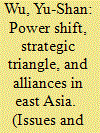

|
|
|
|
|
| Publication |
2011.
|
| Summary/Abstract |
This paper complements the traditional realist perspective (TP) with the strategic triangle theory (ST) in analyzing alliance formation and shift in East Asia. Alliance is perceived as a marriage triangle, and is subject to the dynamics of strategic actions taken by players to elevate their roles in the game. During the Cold War; two hierarchically structured alliance systems opposed each other in East Asia. Power shift in the continental system disrupted the Sino-Soviet pact, while hegemonic stability; in the maritime system buttressed the U.S.-led alliance. The division in the con-tinental system offered Washington opportunities to befriend Beijing and buttress its position in the U.S-Soviet-PRC strategic triangle. Washing-ton's allies were prompted to act likewise. The tension in competitive rapprochement was absorbed by the hegemonic structure of the maritime system. The, result was collective hedging (balancing-cum-engagement). In the post-Cold War era, the predominance of the United States caused the revival of the Beijing-Moscow nexus, now constructed as an equal partnership. Again one finds the continental and the maritime systems facing each other. Cross-system hedging is inevitable as this would increase the payoff of strategic players. Russia and Taiwan are examined in the above context, combining the perspectives of both TP and ST. The rise of China is expected to cause tension in the continental system. As predicted by the internal security dilemma. The rise of China also impacts on the maritime system by both increasing the tendency to balance it (as predicted by TP), and to improve relations with it (as predic1ed by ST), hence prompting hedging. However hedging is difficult for Taiwan, for it is only loosely connected to the maritime alliance..
|
|
|
|
|
|
|
|
|
|
|
|
|
|
|
|
| 20 |
ID:
061840


|
|
|